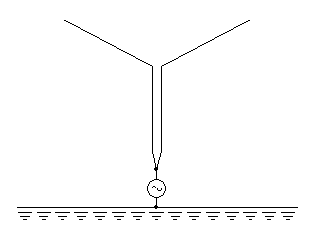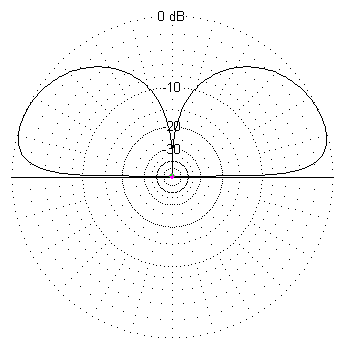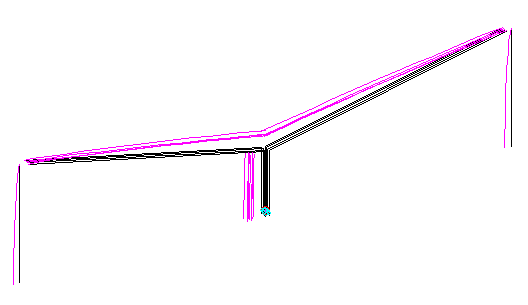
In order to get a rough idea of the performance of such antenna, it has been simulated and the gain, the radiation pattern, the antenna impedance and the current distribution has been calculated. Precise data about the structure are not available and the dimensions have been estimated via observations on site. No antenna performance data is available and therefore the result of the simulation cannot be checked against the reality and may be considerably wrong, but the figures look plausible and are reported and commented below.
The spare antenna of the Monte Ceneri Cima transmitter is a short vertical cage suspended between two metallic poles by a capacitive hat. In spite of one could think it's not a dipole. The base of the cage is insulated from ground and connected to the feeder via a matching network. Transmission frequency is 558 kHz, one wavelength is 538 m and a quarter wavelength is 134.4 m.

Ground conductivity has a very big influence on the gain (the higher the conductivity the higher the gain), the elevation angle (the higher the conductivity the lower the angle) and the impedance. Unfortunately no information about ground conductivity is available. A value of 7.5 mS/m has been arbitrary chosen.
The simulation shows a gain of 1.1 dBd (including losses), which is not as good as the 1.6 dBd of the main antenna, but is still fair. The elevation angle is 22° and a half power beam-width of 51°. A very low radiation angle is important for long distance broadcast, but such a small antenna can only achieve 22° (compared to the 14° of the main antenna). The radiation pattern shows no side lobes at high angles, meaning reduced fading in the reception, which is a very important feature of a broadcast antenna, but still this antenna radiates more energy toward the sky making it less performing against fading as the main antenna. The antenna is almost omni-directional in the horizontal plane; the two poles only slightly modify the pattern by making the gain 0.5 dB higher in the direction of the poles.

The current distribution on the mast is the typical one of short antennas (shorter than λ/4). The maximum current is 65 A at the feed point. The feed impedance is (4.5 – j41) Ω, meaning that for a power of 150 kW, the feed current is about 65 A and the feed voltage is 2.7 kV. To have a comparison, 150 kW on a 50Ω resistive load require a voltage of 1 kV and a current of 19 A.
Remark: the power on the spare antenna is limited to 150 kW.

The currents in the hat are in opposite directions and their radiation cancels each other; almost no radiation comes from this part of the antenna and this is proved by the fact that the antenna is almost omni-directional in the horizontal plane. So the question: how would this antenna perform without the capacitive hat? In order to have a better comparison, the cage has been supposed to be as high as the masts (in the real antenna the capacitive hat is tilted and the cage is lower than the masts).
The simulation shows that the gain is lower (0.9 dBd), the elevation angle is also lower (20°) and the half power beam-width a little smaller (47°). But the big difference is in the feed impedance which is now (2.2 – j370) Ω making a real challenge to match this impedance to a regular 50 Ω transmission line. The feed voltage would be around 35 kV and the current around 95 A, meaning an apparent power of 3.3 MVA for just 150 kW active power. If such an antenna were constructed, a great part of the power would be wasted in the matching network.